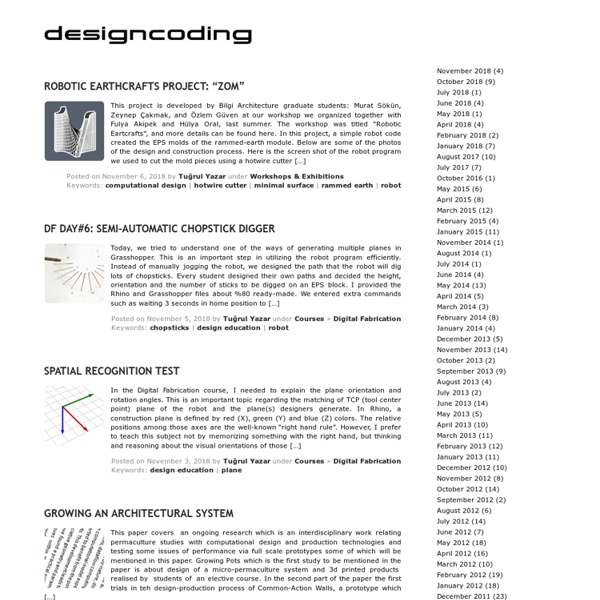



Scientific Publications Geometric Multi-Covering.R. Strauss, F. Isvoranu, G. Large scale double curved glass facades made feasible - The Arena Corinthians West Facade.A. Ruled Free Forms. Architectural Caustics — Controlling Light with Geometry. Architectural Geometry from Research to Practice: The Eiffel Tower Pavilions. Design of Self-supporting Surfaces. Paneling the Eiffel Tower Pavilions. Case Studies in Optimization of Glass-panelized Architectural Freeform Designs. Circular Arc Structures. Case Studies in Cost-Optimized Paneling of Architectural Freeform Surfaces. Tiling Freeform Shapes With Straight Panels: Algorithmic Methods. Statics-Sensitive Layout of Planar Quadrilateral Meshes. Ruled Surfaces for Rationalization and Design in Architecture. Designing Quad-dominant Meshes with Planar Faces. Paneling Architectural Freeform Surfaces. Geodesic Patterns. Packing circles and spheres on surfaces. Freeform surfaces from single curved panels. Curved folding. Geometry of architectural freeform structures.
Generative Art - Autonomy: Cellular Automata The most familiar single example of an autonomous agent, to you at least, is the one staring at this page. You, dear reader, with your behavior on any particular day defined by a complex mix of biology, psychology, and the comfortableness of your footwear, are an autonomous object, creating interesting patterns in the data you create. Most everything you do these days leaves a data trail: every purchase you make, every point you earn on your store card, every link you click, and every journey you take. The cards in your wallet are writing your economic autobiography, your tweets and SMSs are writing an ASCII diary as part of a social map, and the phone in your pocket is drawing a GPS picture of your daily psycho-geography. To familiarize you with the concept of autonomy and the emergent complexity of this breed of object, we’ll play one of the early parlor games of computer science: cellular automata. In the 1970s, the field of computer science was obsessed with cellular automata (CA).
Inorganic Speciation Inorganic Speciation by Iain Maxwell + Dave Pigram (supermanoueuvre) Form is the primary instrument through which architecture engages with the world. It is this firmly held position that motivates supermanoeuvre to develop custom methodologies of formation that allow for the explicit and open-ended negotiation between multiple architectural intentions and the complex milieux within which they will operate. These methodologies are algorithmic in nature, primarily digitally enacted, and extend the capacities of the form-finding tradition within architecture through a decoupling of its processes from the limits of physics, enabling a broader examination of the number and nature of negotiable inputs. The abstract notation underlying these algorithms enables a meta-analysis of the formational processes, which has an accelerating influence on their evolution, as experienced within other fields of intellectual and artistic endeavour. -Source Like this: Like Loading...
Rhino Python Tutorials – Plethora Project Plethora-Project.com is an initiative to accelerate computational literacy in the frame of architecture and design. It aligns with the "show me your screens" motto of the TopLap live-coding group attempting to get rid of Obscurantism in digital design. Directed by Jose Sanchez Contact me at : jomasan@gmail.com Bio: Jose Sanchez is an Architect / Programmer / Game Designer based in Los Angeles, California. Fabrication Grasshopper: Parametric CurvesThis module covers the basic parametric properties of curves along with common grasshopper methods for evaluating and dividing curves. ARCH 598 Summer 2011information >> n-formations FABRICS // LATTICES // FIELDSThis course is designed to introduce and explore computational design, algorithmic thinking, and digital manufacturing–both: the larger ramifications that emerging digital technologies and ideas are having architectural theory via readings, discussions, presentations; and the practical application of these ideas and tools through a series of hands-on, iterative modeling and fabrication assignments. ARCH 581/498 : Fall 2010Digital Design + Fabrication Foundations I Grasshopper: Surface to Planar TrianglesGrasshopper : Surface to Planar Triangles : Fabrication Layout of Planar Components Laser Cutting: Adobe IllustratorLaser Cutting from Adobe Illustrator
Owen Architects - Online Professional Portfolio Southern facade of a project using a mechanical iris system for light regulation. Prefabricated Mechanical Iris panels. We have included the files you will need to create your own mechanical iris. Owen Architects For the arduino section you will need to download the software from arduino.cc and buy the following items (images of all necessary items shown above: in order of tp to bottom, left to right). Download the Mechanical Iris Arduino sketch needed to make this project: Mechanical Iris + Servo Motor - Arduino Sketch. Download the Mechanical Iris Arduino sketch needed to make this project: Video showing how to set up the arduino with photoresistor and servo motor.